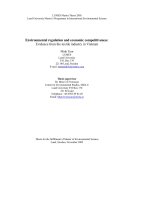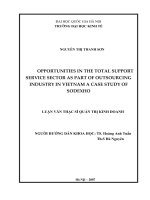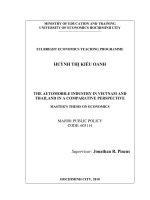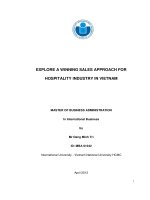CASHEW NUT INDUSTRY IN VIETNAM
Bạn đang xem bản rút gọn của tài liệu. Xem và tải ngay bản đầy đủ của tài liệu tại đây (542.85 KB, 9 trang )
12
3. CASHEW NUT INDUSTRY IN VIETNAM
3.1 SAMPLE DESCRIPTION
Map 01. Annual cashew nut output in Vietnam Map 02. Study sites of Binh Phuoc and Dak Nong provinces
This section accordingly proceeds to provide a brief explanation of sample area, an indispensable
introduction of focused interviewee, questionnaire and sample size employed in the empirical study.
Cashew nut planted areas in Vietnam have mostly been allocated in the South, especially in the
Southeast of Vietnam (see Map 01). Being prominent among these provinces, Binh Phuoc and Dak
Lak which has now been divided into Dak Nong and Dak Lak provinces have highly attained large
planted areas and high output. Ranked number 02 among several multi-year industrial crops
namely, coffee, rubber, pepper and cashew, cashew nut in Binh Phuoc province has accounted for
35% of planted areas in the whole country (see Table 02). This appreciation has come from not
only cashew’s highest production area, its supply for the development of processing industry,
export performance but also from its important socioeconomic role to farmers (GSO 2002, p. 76;
DoTT, p.134). Following coffee, cashew nut is also ranked number 02 among several multi-year
industrial crops in Dak Nong province. Cashew nut in Dak Nong has achieved the highest annual
growth rate of planted area, especially in 2004 and 2005 at 266% and 314% respectively.
Empirical study site
Cashew planted area has rapidly increased, posting an annual growth rate of over 10% in 2002-
2005. Export performance has annually grown higher than 40% in 2001-03; in the recent two years
2004-05, though the export growth rate has not been highly achieved, it has still remained at high
volume. Among districts in Binh Phuoc, Bu Dang, Phuoc Long and Dong Phu have the highest
cashew nut production, amounting to 83% in total production and 85% in total output in 2005
(Appendix 2.2). These three districts have currently the highest portions of households under
cashew cultivation and the largest crop volumes, reporting at 80% in total households and 84% in
total cashew nut respectively; well as their different development states (Appendix 2.3). We
therefore choose Bu Dang, Phuoc Long and Dong Phu for our empirical study.
13
In the same manner, we find Dak Rlap district as a prominent one in cashew nut production. Within
the district, we choose particularly QuangTin and Dak Rtih for their highest planted areas of cashew
and populousness of ethnic minority (Appendix 2.4, 2.5 and 2.6).
Table 02. Cashew plantation, output and export in Vietnam 1999-2005
1999 2000 2001 2002 2003 2004 2005
Planted area (Ha)
Vietnam 185,200 195,600 199,200 240,200 261,500 295,900 328,000
Binh Phuoc 64,830 70,524 69,887 95,554 99,539 107,939 116,029
Dak Nong 2,498 2,491 2,790 2,534 2,507 6,665 20,930
Gross output (Tons)
Vietnam 35,600 67,600 73,100 128,800 164,400 204,700 232,000
Binh Phuoc 9,570 19,214 19,396 61,919 69,032 98,130 114,985
Dak Nong 759 321 1,526 1,269 1,940 3,728 6,653
Export (Tons)
Vietnam 18,400 34,200 43,600 61,900 82,200 104,600 108,800
Binh Phuoc 1,372 1,426 2,163 3,417 4,908 5,406 4,712
Dak Nong
23,406
6
7,861
Source: GSO (2006), Binh Phuoc GSO (2006), Dak Nong GSO (2006)
Sample size, questionnaires and interviewee
The questionnaires (see Appendix 01) are designed to interview all stakeholders in the value chain
of cashew nut including farmers, traders (dealers, purchasing stations and manufacturing
companies). For farmers, it is designed to explore three main areas namely, general households’
information, transaction behaviors between household and trader and factors determining farmgate
price under the hedonic pricing approach. For traders and processing company, the questionnaires
aims to analyze cost and benefit in their cashew nut business, their relationship between farmers
and their buyers either processing companies or purchasing station level 01.
The household interviewees are persons who take responsibility of household‘s cashew nut sale,
commonly household’s head. The sample size is 100 households under cashew plantation at least
three years old. As for each household, there are possibly two to five different cashew nuts’
farmgate prices for all transactions during the study year. Totally, 253 observations/transactions
conducted by these 100 households enter into the estimation. Appendix 4.2 and 4.3 gives statistic
description of dependent variable and explanatory ones in the empirical estimation.
As for traders, there are 18 samples of traders including purchasing station level 01, purchasing
station level 02, and dealers in the two provinces. As in DakNong province there is not any
purchasing station level 01, trader interviewees are only dealers and purchasing station level 02.
There are also two samples of processing companies, one in Binh Phuoc province and one in
DakNong province.
6
Export volume is higher than the output in cashew nut production in the area as the local processing companies can
purchase cashew nut bean from neighboring provinces like Binh Phuoc for their processing and exporting
14
3.2 POLICIES AND INSTITUTIONAL FACTORS
Institutional factors in cashew nut industry
Figure 01 describes participants and stakeholders in the cashew nut industry. Farmers demand
several input factors for their production which are supplied by both private and public sectors
including seed, fertilizer, pesticide, irrigation, water, electricity, technology and others. While some
factors are better supplied under market mechanism, other input factors have called for the GoV’s
participation and other supporting program such as irrigation, electricity and technology. These
factors are detailed in supporting factors. Four main supporting factors in cashew nut production
are technology transfer either from Agricultural Extension Center (AEC), Plant Protection Division
(PPD)
7
or directly from the research institution and universities like Nong Lam University; sale on
credit support from fertilizer and pesticide companies; input support from the Government’s
program like supporting price of highly yielded seed and other market supports such as information
on the market price in the international market.
Prominent among these four factors, technology transfer has popularly been carried out in
DakNong and Binh Phuoc through the AEC, PPD, and agricultural companies under their marketing
strategies, research institution and university. Farmers have received technology transfer and
usually in accompany with samples of advanced seed, newly developed fertilizers and pesticide.
Financial supports include supporting price of seed, and credit program which has gone together
with certain kind of crops or animals under the GoV’s recommendation including cashew nut as a
strategic crop. The fact that has highly achieved in Binh Phuoc, not yet in DakNong is sale on credit
from fertilizer and pesticide companies. A poor farmer as a member of Farmer Association can
purchase fertilizer and pesticide on credit at 50%, repayable remaining 50% after their harvesting.
The requirement for such a sale on credit performance is the existence of a formal organization as
a legal entity in making transaction with companies. These are either Farmer Association or Farmer
Club in Binh Phuoc. Though Farmer Association in DakNong has already established, it has
however not performed such an activity to serve its members.
Meeting with local authorities Research team discussion
The cashew nut industry’s performance is also observed by the GoV, particularly the DARD and
MARD in regard to planning on planted area, output and yield; the AEC and PPD regarding more
detailed on technology, control on fertilizer and pesticide; Vietnam cashew nut Association
(VINACAS) as a representative of cashew nut processing companies considering cashew nut’s
7
AEC and PPD belong to the Department of Agricultural and Rural Development
15
quality and trading in the local market. In addition, individual purchaser and processing companies
has also more direct control and evaluation on cashew nut’s quality in the market.
Working at night with farmers Group discussion with farmers
Cashew nut bean from farmer is sold to the market mostly into two channels (1) dealers,
purchasing station level 01 and processing companies; (2) purchasing station level 02, purchasing
station level 01 and processing companies. The fact that farmer sells cashew nut directly to
purchasing station level 01 is so rare in Binh Phuoc. And there is no such a case in Dak Nong as
there is not any purchasing station level 01 in DakNong. Farmers in some cases have kept a part of
their cashew nut bean as seed in the next crop.
Some farmers have started certain post-harvest activities to increase value added in Binh Phuoc
province while such activities have not yet performed in DakNong province. Processing can be
divided into 04 main steps, namely drying, steaming, peeling and kernel processing. Within these
four steps, the first three steps can now be carried out by farmers. Though processing companies
have also performed all processing activities in their premise, they gradually hand over the first
three steps to farmers and traders. Farmers conduct these post-harvest activities for their own
cashew nut and then sell partially processed product (by-product) to processing companies for
further processing step instead of cashew nut bean. Alternatively, farmers perform these post-
harvest activities for others to receive their based-product wage as processing labor cost.
Relevant policies in cashew nut industry
• Policies on cashew plantation
Sale on credit of input production from companies: Cashew nut has now been considered as a
strategic plant in Binh Phuoc and DakNong provinces. There have three main policies on plantation
in Binh Phuoc and DakNong provinces. The first is sale production input on credit to farmers
without any interest rate. As mentioned, this activity has not yet been achieved in DakNong.
Actually, such a performance is not the GoV’s policy, but it has derived from the demand and
supply in the input market. Farmers have demanded fertilizer and pesticide but they are in lack of
capital for investment, while input supply companies can sell these inputs on 50% credit repayable
after 12 month period of this annual crop.
Supporting highly yielded seed from the GoV’ s program: The program has carried out through
AEC and PPD so as t
o encourage farmers to apply highly yielded seed, change from old variety
to grafted cashew nut variety. However, the program’s achievement is still a controversial issue as
such a new variety application also requires high investment of capital, technology and labor which
is not easily attained for the ethnic minority farmers and in remote area and poor farmers.
16
GoV’s support for the operation of Farm Association, Farm Club and AEC and PPD: Most of these
organization operations are technology transfer through training and seminars.
Other supporting policies are (1) exemption of tax on using agricultural land to perennial crops
including cashew nut, (2) building up grafted cashew model and (3) credit support program in
general to poverty alleviation.
• Policies on cashew nut trading
Permission of newly established purchasing stations of processing companies outside the province:
Since 2003, the Department of Trade and Tourism has permitted the establishment of purchasing
station of processing companies outside the province. The increase in numbers of purchasing
stations in Binh Phuoc province has actually enlarged the demand for cashew nut not only from
local processing companies but only from processing companies outside the province.
Bonus for export volume to processing companies: This is the GoV’s policy to encourage
processing companies’ exportation. Processing companies will receive a bonus from the GoV’s
budget at a certain high exportation volume.
Vietnam cashew nut Association (VINACAS) as a representative of cashew nut processing
companies has also efforts to observe cashew nut’s quality and trading in the local market. In 2003,
it tried to determine the purchasing price among its member in the local market; the price however
operated under the market mechanism. Such a price determination has not been appeared since it
has been unable to put in action. In 2005 and 2006, to keep the cashew nut’s quality in the local
market, it has strictly observed the quality through setting up criteria for each grade. Such guidance
has found useful in trading as both farmer and trader has a base in making transaction.









